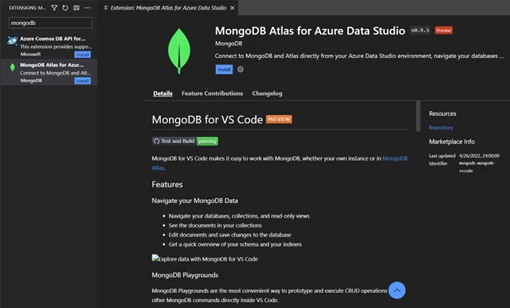Azure Data Studio 1.41 release
We are less than one month into 2023 and already have a new release of Azure Data Studio to share—introducing 1.41! With this release, we migrated to a new authentication library, made improvements based on user requests and feedback, and addressed a slew of existing issues that had been logged by users—including some that were really old. We would like to express our gratitude to the community for creating issues in GitHub, and for engaging with the engineering team when more information was needed. To those users that provided logs or more detail about their environment and the problem: thank you. We often need additional details to pinpoint the root cause of an issue, and we can do that faster thanks to your help. We will continue to engage with users as we improve the reliability of Azure Data Studio and add new features throughout 2023.
Azure Data Studio
A modern open-source, cross-platform hybrid data analytics tool designed to simplify the data landscape.

Connectivity
The migration from the Active Directory Authentication Library (ADAL) to Microsoft Authentication Library (MSAL) was a significant undertaking by the team. This was necessary as ADAL support ends in June of this year, and it provides multiple benefits for those environments using Azure Activity Directory (AAD). AAD users should notice an improved and more reliable experience, particularly around token refresh and connection stability. This also helped us fix an issue in the MySQL extension for AAD.
Additional changes include improved loading of Azure resources and new Dedicated SQL Pools and Azure Synapse Analytics nodes in the Azure tree. Azure Data Studio 1.41 also provides the ability to customize the name of firewall rules for Azure SQL and adds support for connecting to a server alias (versus a server name).
If you have applications that use ADAL, please see the Migrate applications to the Microsoft Authentication Library (MSAL) page for more information.
Object explorer
A new area of focus in this release is Object Explorer (OE), and this will continue to be an area we improve upon in the next few releases. Those with serverless Azure SQL previously reported issues with folders not expanding correctly, and with databases being brought online (thus incurring costs) when it was not expected. Other users noted that expanding OE timed out after 45 seconds. We have addressed all these issues in this release, in addition to adding support for Ledger Views.
Query results
The query results window got a fair bit of attention this release as we work through the backlog of open issues. First, we introduced a new configuration option to show or hide the action bar in the query results view. The Query Editor > Results: Show Action Bar option can be found in the command palette (CTRL + , ) if you type Show Action Bar. By default, the action bar is shown in the query results pane, as seen in the screenshot below:

There are also improvements around opening JSON files and the visibility of the horizontal scroll bar in the query results pane. Azure Data Studio 1.41 now correctly handles line breaks in cells when copying from the results grid and pasting to an editor, and the auto-resizing of columns in the output pane has been updated to better display column contents. Finally, cell selection and navigation in the results grid have been enhanced, and we introduced additional summary details when selecting multiple cells in the results window:

Extensions
Multiple teams have been working on updates to various extensions available from Azure Data Studio. For SQL Projects, we have improved the experience of finding projects by providing a dropdown that lists saved projects, rather than requiring users to browse to their location. We had reports that differences in schema compare were not highlighted correctly, and that problem has been fixed.
Users of the SQL Migration extension will see an improvement in the migration process as we better support migrations to specific subscriptions (such as government), and the extension now includes the Premium Series Memory Optimized SQL MI SKU as a recommendation where appropriate.
MongoDB and Microsoft Azure continue to build on their partnership by introducing an extension for MongoDB Atlas and Azure Data Studio on the Azure Marketplace. This Extension is available in Public Preview as of today, Wednesday, January 25, 2023. You already know that Azure Data Studio is a modern open-source, cross-platform hybrid data analytics tool designed to simplify your data landscape, and customers can use Azure Data Studio to work with their data sitting in one or more Azure data services. MongoDB Atlas on Azure provides a fully managed solution for MongoDB in the cloud, and you can now seamlessly connect to and query data on MongoDB Atlas right from Azure Data Studio. This allows you to interact with data on MongoDB Atlas alongside other data services and provides a unified view of your data estate. If you are an Azure customer that is curious about building applications with MongoDB Atlas and want to amplify your integrated experience inside Azure Data Studio, try Pay-As-You-Go Atlas on the Azure Marketplace today!

With this 1.41 release, the Polyglot Notebooks extension will be removed from the Azure Data Studio Extension Marketplace. For a polyglot notebooks experience, we recommend folks use the Polyglot Notebooks in Visual Studio Code.
Odds and ends
Continuing on our path of adding support for arm64, we now include support for arm64 on Windows. Whether you run iOS or Windows, Azure Data Studio 1.41 now provides the capability to leverage arm64, resulting in improved performance.
We are pleased to see users embracing Table Designer and Query Plan Viewer, two features that became generally available (GA) in the November release. In 1.41 we fixed an issue related to opening Table Designer for Ledger tables, and one related to creating a table when another table with the same name already exists.
There were also two requests specific to Query Plan Viewer that got attention in this release. When saving query plan files from Azure Data Studio, we now incrementally append a number to the end of the file for unique naming, and we’ve altered the default folder location when saving plans for a more consistent experience.
Lastly, we had previously announced that we were removing Big Data Cluster functionality from Azure Data Studio. This removal has been delayed until a later release.
Looking forward
We are already at work on the next release of Azure Data Studio and are making plans for what we want to accomplish in 2023. You can expect that we will continue to review backlog issues and address them as they relate to an existing area of focus. We have more changes coming related to the connection dialog and object explorer, and you will also see improvements in user management. Finally, if you see a comment on an issue you opened–whether recent or ages ago–please feel free to respond and provide more information if you are able.
